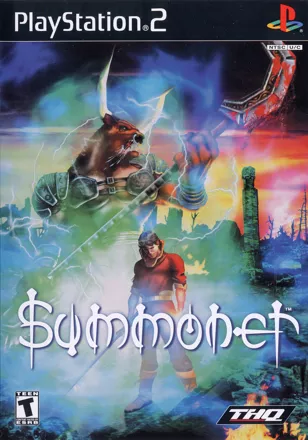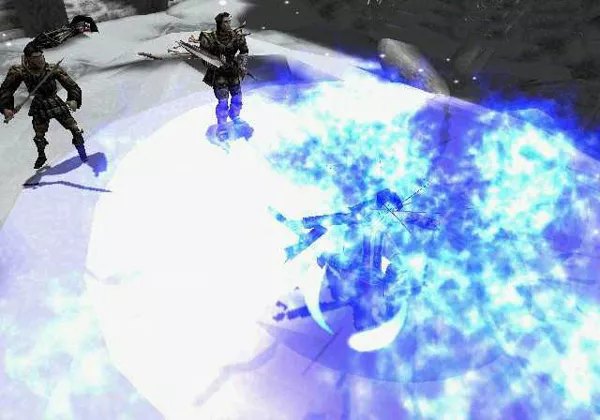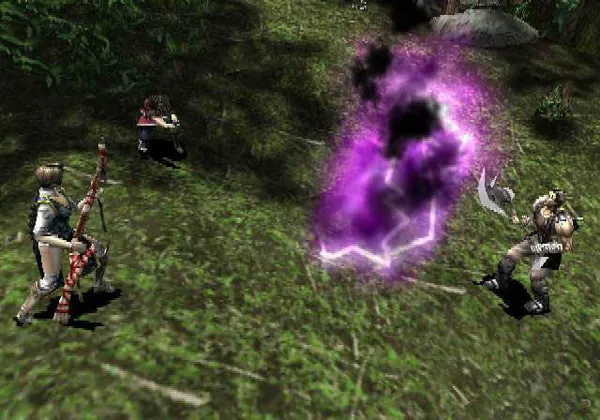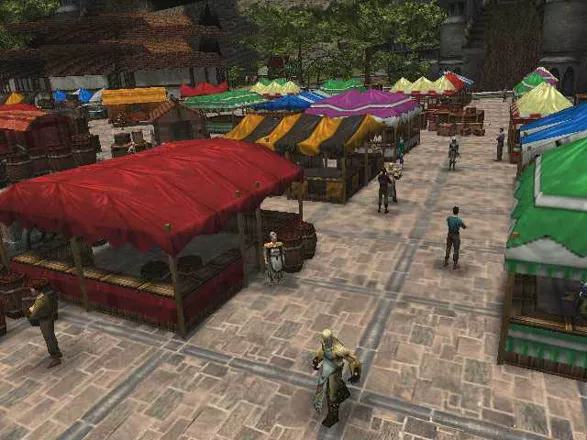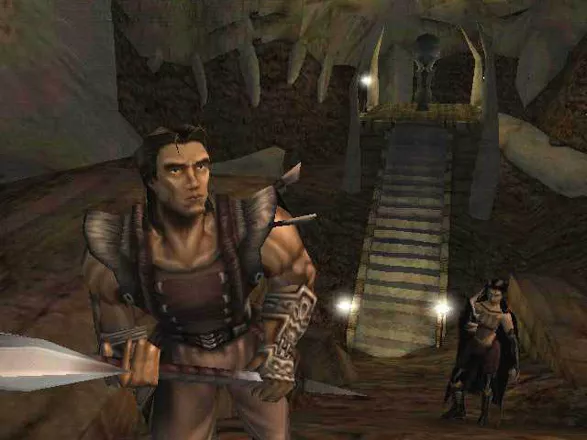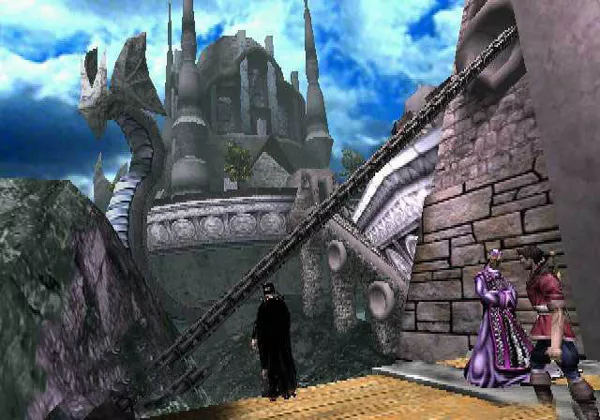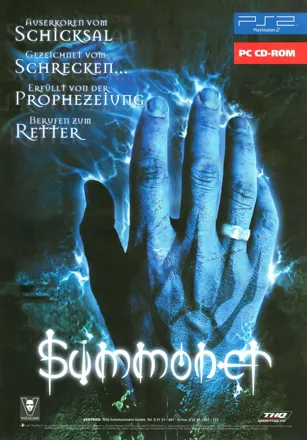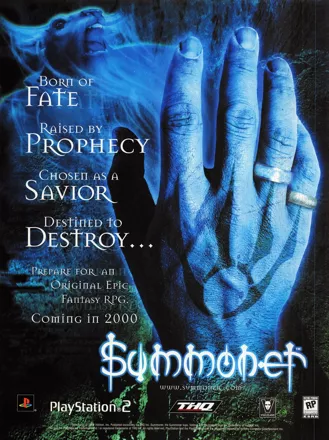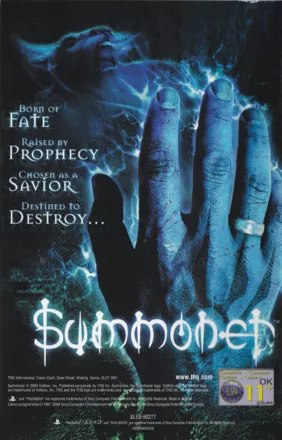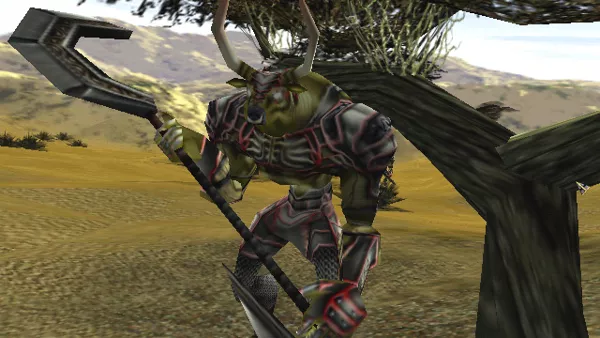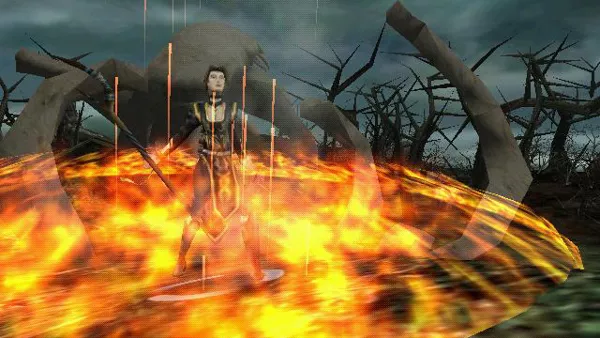Summoner
Description official descriptions
Joseph was a simple boy living in the village of Ciran. One day, a mysterious man gave him a magical ring containing the power to summon demons. When Ciran was attacked by raiders, Joseph used the ring, but could not control its power, and the demon devastated the village. Joseph vowed to never use the ring again. But things change when soldiers from Orenia, a continent ruled by Emperor Murod, attack the town Joseph has settled in, looking for a boy born with the mark of a Summoner. Joseph has to flee and find companions as he realizes that the Emperor must be stopped at all costs.
Summoner is a 3D story-driven role-playing game somewhat influenced by the Japanese variety of the genre, having a linear plot progression and random enemy encounters. The player controls a party of characters who join the protagonist as dictated by the plot. Combat flows in real time, with the player actively controlling only one character. The others can be given general orders regarding their usage of spells, melee or ranged attacks, etc. The controlled character can execute combo chains if the player presses a key at the right moment. At some point in the game Joseph gains the ability to summon powerful monsters to help the party in battles. The game also features side quests and skill-based character development.
Spellings
- 召唤者 - Simplified Chinese spelling
Groups +
Screenshots
Promos
Videos
Add Trailer or Gameplay Video +1 point
See any errors or missing info for this game?
You can submit a correction, contribute trivia, add to a game group, add a related site or alternate title.
Credits (PlayStation 2 version)
99 People (79 developers, 20 thanks) · View all
| Additional Design | |
| Franchise Lead Programmer | |
| Console Lead Programmer | |
| Additional Programming | |
| Lead Artist | |
| Concept Artists | |
| Animators | |
| Writers | |
| Level Scripting | |
| Composers/Sound Designers | |
| Assistant Producer | |
| Executive Producer | |
| Lead Designer | |
| QA Test Lead | |
| [ full credits ] | |
Reviews
Critics
Average score: 74% (based on 46 ratings)
Players
Average score: 3.1 out of 5 (based on 42 ratings with 4 reviews)
Sub-par console effort with few saving graces.
The Good
Summoner is your average console-styled rpg that casts you as a weakling warrior whom upon a catastrophic event that shatters his loved hometown, must leave to embark on an epic journey that (obviously) leads to the fulfillment of an ancient prophecy. The thing with Summoner is that to distance itself from the usual western efforts at console-styled rpgs it adds a series of nice ideas and features usually not seen outside of PC waters. You have an effective skill-based system which awards skill points whenever you level up and which effectively allows you to customize your characters in a more in-depth fashion than the usual console rpgs by giving you a list of atributes and skills to use those points on. You also have a more in-depth use of equipment and items with several types of armor pieces to take into account and with included restrictions and pros/cons. I don't really know wheter to include this but considering that on most console rpgs you just have to worry about wearing the gold armor instead of the silver one, Summoner's system of leggings, bracers and vests with different and contradictory effects must seem like fricking rocket science to most console players.
As you explore the world you'll traverse between huge cities and towns designed so as to encompass two distinct kingdoms and visual styles, a traditional european medieval one and a feudal japanese inspired one, both realized with luxury of detail and with plenty of lush and elaborate locations and characters. Obviously, the game has you exploring this areas to gain the quests that lead you into different dungeon romps were you have to kick some booty, while at the same time including light puzzle/sneaking sequences to spice things up.
Combat-wise the game introduces a mixture of arcade and tactical action, with you being able to pause the action at any time and issue orders to your party members. As combat progresses though, you can take control of any particular character and continue in real time, with the added bonus of being able to chain hits by timing your attacks with a group of function keys that change from character to character and which cause various effects such as health/mana regeneration, knocking down a character, cause a different type of damage, etc... The game thus emphasizes melee combat over everything else, but you can effectively use a selection of offensive spells and special skills (like backstabbing, etc.) selectable from a pop-up menu or a handy customizable easy-access toolbar. Good fun, if a bit oversimplified, but what the heck.
The other interesting thing combat-wise is Joseph's (the main guy) ability to summon a specific monster to aid the party when collecting a series of magical rings and adding them as a fourth party member who becomes controllable in the same fashion and comes loaded with his own brand of special skills/spells. These characters don't level up in the same way as the main characters but instead rely on you equiping their specific rings and collecting exp. points with them to make the creatures stronger, give them better skills and eventually unlock upgraded versions of the monsters. You can also unlock one-time Final Fantasy-like summons that trigger a little cutscene and deal a massive amount of damage.
All of this gameplay is viewed from a 3rd person perspective in a 3D enviroment much like on Microsoft's Dungeon Siege. Only the camera pans and switches to a top-down perspective whenever on combat and closes in for npc interactions. The graphics themselves are very good, with only stiff models and animations to object to and with all manner of nice effects and enviroments to explore.
Finally, the conversion makes a good use of the pc platform and ends up being one of the best conversions to any console game ever. Why? Well, apparently the guys at THQ/Volition noticed how we have that thing called a mouse and a keyboard, and thus the game uses them to control itself much like (once again) Dungeon Siege, except the game doesn't play itself like on that game and you actually have to control your party and actions (Shocking!!).
The Bad
Lots of stuff to point at. For starters the storyline is the same old rpg crap that revolves around you being the re-incarnation of some mythical god of blablabla, and having to fulfill your prophecy by running around and asserting yourself as the "Summoner" while a couple of warring kingdoms face off in their eternal quest to rule over the land. All the "shocking" betrayals and stupidly forced plot twists that you have come to expect from Japanese rpgs are somewhat jammed in here as some sort of compendium of the genre with all boiling down to going and killing Gonzo the bad guy to decide the fate of the world, universe and democracy...
The characters and npc's are extremely underdeveloped, a common feature of console rpgs which don't favor dialogue trees and stuff like that and that populate their worlds with "signpost" npcs that spout directions, clues and assorted stupidity when clicked on, but for this particular title the npcs are even less of a virtual entity and more of a walking signpost. It seems that the developers got really proud with the virtual world they created and desperately want to share every myth and backstory they made for it, so each npc in the world will usually ramble on and on about their history and whatnot... geez, thankfully you have a "!" icon over some characters to point out which of them are really important to talk to, otherwise you would be lost in an unending sea of lame fantasy history lessons. But aggravating as that may be, the big beef comes with the main characters which you would at least expect to be a little developed for the sake of dramatic tension. No such thing here. Each of the main characters engage in the same dense "reading off a script" conversation where they just say what they have to say and move on. This type of interaction kills any emotional link you may want to feel for them and trashes what should be emotional or at least dramatically important moments. There's a part where your cliche'd female thief character Fleece is informed that she really is (as per console rpg regulation #445423) the exiled princess of her land and that her real history is blablablablabla... what do the characters do? After the speech is done (without any sort of narrative aids to try to trigger a response from the player) the game just switches out of dialogue-mode and moves on!! WTF??? After years of Final Fantasy-styled games where every minor event triggers a melodramatic sequence were each character ponders every philosophical question and it's implications with their "complex" soap-opera situations, I was more than shocked to witness the stone cold reactions of the characters in this game! "Ok, so your entire life is a lie, ready to move on?"...Riiiight. The equally sterotyped "tank" character hates the main protagonist, and states it so when they join up, but what do they do beyond that?? Nothing! There's a "Uh, I hate you" speech and then it's time to move with the game...cool, uh? And that's without dwelling into the typically forced plot twists were someone betrays someone, gives a stupid speech to somehow patch the plotholes that their poorly developed actions caused and things just move on!!...
So much for story and originality right? The gameplay itself boils down then to a nice dungeon-romp as described above, but some elements like extremely poor AI for both your characters (Dumb F%$KS!!!) and the enemies (Ha-ha, stupid losers!) makes things terribly boring and non-challenging, specially if you exploit some of the badly balanced skills like Fleece's backstabbing or the firewall spell (which works nothing like you would think it would but can still be used to scorch enemies in seconds). As for the sidequests, most console gamers seem to get rashes when faced with them so the design team decided to keep them as dumb-ass as possible so as not to overtax their short attention span. The result is the worst-ever assembled collection of Fed-Ex quests and pixel hunts since Anachronox, with just as much frustration and boredom attached to them. There is even a particular one that I managed to complete (which stands as a proof that I had absolutely NOTHING better to do than to play Summoner at the time) that seems almost like a joke from the developers and which has you traversing all over the world looking for a stupid good luck charm. Every time you get to whoever is supposed to have it he goes "oh no, I sold that/lost it/got stolen by XXX, who as y'know, lives on the other corner of the world".....good god...
The Bottom Line
While a collection of nice ideas and good technical development attempt to bring this console-born title out of the gutter, a tremendous lack of creativity when creating the plot and characters, plus horrible interaction and zero use of scripting for dramatic purposes make this game nothing but an averagely flawed dungeon romp with deliriums of grandeur where the action is the only half-decent diversion. Forgettable, very forgettable.
Windows · by Zovni (10502) · 2003
For a Windows game, it's a half-decent console title.
The Good
This should have been a fun game, with the innovative ideas for a magic system and story. While playing through the initial area I was pretty excited, it was oddly reminiscent of Dungeon Siege but much more interactive.
The Bad
Sadly, once you leave the initial encounter you find that you've been saddled with a bad port from the consoles.
The world map is so low-resolution and visually hashed that you can't read anything but the main city location and a vague idea that the terrain north of there is different from that in other directions. Worse, you will be given quests that depend on being able to read that map - "go to the hill northwest of town".
The quest journal is incomplete and spotty, so if you want to remember what you've been asked to do you need to keep pen and paper handy. There's no automap, so you are on your own trying to remember where a given shop or person was.
Too many of the quests involve trudging back and forth across zone loading boundaries, and (I'll mention it again) trying to remember where you found that shop that you've now been asked to visit.
Combat, even granting that this is an "action RPG" is too dependent on reflexes and button control - what you might expect on a console with a gamepad but out of place in a PC game; even if you have a gamepad for your PC it's too much like Mario and too little like Diablo.
The Bottom Line
It might have been a good console action RPG a la the more recent Zeldas, but the port is terrible and the game itself is too reflex-oriented and shallow to compete on Windows.
Windows · by weregamer (155) · 2003
Absorbing RPG that almost lives up to the hype.
The Good
Summoners story is good. It has a rich and full history with much to learn and explore. The main quest is fairly epic with some great cut scenes to help move it along and if that wasn't enough for you, there are also numerous sub quests that you can embark on if you wish. These are not essential to the games completion but contain rewards for those who choose to do them.
The combat system is very simple, yet effective. Your characters attack and defend automatically but by clicking the right mouse button at the appropriate times, you can chain combos together for maximum damage.
The quests involve many numerous game types such as puzzle solving and stealth missions. These rarely become dull and are interesting enough both visually and in terms of gameplay to keep you going. The graphics are good, at times they are beautiful such as in and around the palace in the first town and the music is equally epic. Finally the speech is very nice and suspends disbelief quite effectively.
The Bad
There is an awful lot of running around to do which can become quite tedious, especially when you have a lot of quests to perform since it's easy to lose track of where you need to go for each one. It's not uncommon to find yourself unaware of where you need to go and thusly running around until you stumble upon the answer. Some of the quests are also rather obscure and it's not always apparent what you need to do even when you're supposed to know.
The characters look a little average graphic wise, often having a pasty gray color about them. The cameras are also quite good at leaving you blind while you run right into a pack of enemies and once you get several characters in your party, it can be difficult managing them in the heat of battle.
The Bottom Line
Summoner is a great RPG with a lot to do but has a few niggles that keep it from being at the top of the heap. Fans of the genre should definitely take a look.
Windows · by Sycada (177) · 2001
Trivia
Funny easter egg: Click on the credits button, and after they all scroll by (or after you skip them) you'll see a pretty funny movie of the summoner characters playing traditional pen&paper D&D with a guest appearance from Volition's Red Faction. It's hilarous and it's also quite long, not just a 2 sec. skit.
The clip was produced by the Dead Alewives, an improv/comedy group from Wisconsin, and written by Dan Harmon. You can also find the movie in the game's directory as (appropriately named) geeks.bik. In the PS2 version, the movie is named geeks.pss.
Analytics
Upgrade to MobyPro to view research rankings and price history! (when applicable)
Related Sites +
-
Official Game Page
THQ's Summoner site -
Summoner @ VBB Exiles
One of the best sites about Summoner,with lots of information. -
Summoner.org
Basically anything you'll want to know about Summoner: news, demos, patches, cheats and walkthroughs, links.
Identifiers +
Contribute
Are you familiar with this game? Help document and preserve this entry in video game history! If your contribution is approved, you will earn points and be credited as a contributor.
Contributors to this Entry
Game added by Kartanym.
PlayStation 3 added by Charly2.0. Macintosh added by Kabushi.
Additional contributors: Zovni, Unicorn Lynx, Jeanne, Drolsmurf, Evil Ryu.
Game added March 27, 2001. Last modified August 2, 2024.


